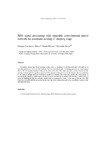EEG Signal Processing with Separable Convolutional Neural Network for Automatic Scoring of Sleeping Stage

Ver/
Use este enlace para citar
http://hdl.handle.net/2183/25954
A non ser que se indique outra cousa, a licenza do ítem descríbese como Atribución-NoComercial-SinDerivadas 4.0 Interancional
Coleccións
- Investigación (FIC) [1682]
Metadatos
Mostrar o rexistro completo do ítemTítulo
EEG Signal Processing with Separable Convolutional Neural Network for Automatic Scoring of Sleeping StageData
2020-06-01Cita bibliográfica
Fernandez-Blanco E, Rivero D, Pazos A. EEG signal processing with separable convolutional neural network for automatic scoring of sleeping stage. Neurocomputing. 2020; 410:220-228
Resumo
[Abstract]
Nowadays, among the Deep Learning works, there is a tendency to develop networks with millions of
trainable parameters. However, this tendency has two main drawbacks: overfitting and resource consumption due to the low-quality features extracted by those networks. This paper presents a study
focused on the scoring of sleeping EEG signals to measure if the increase of the pressure on the features
due to a reduction of the number though different techniques results in a benefit. The work also studies
the convenience of increasing the number of input signals in order to allow the network to extract better
features. Additionally, it might be highlighted that the presented model achieves comparable results to
the state-of-the-art with 1000 times less trainable and the presented model uses the whole dataset
instead of the simplified versions in the published literature.
Palabras chave
Convolutional neural networks
Deep learning
EEG
Signal processing
Sleep scoring
Deep learning
EEG
Signal processing
Sleep scoring
Versión do editor
Dereitos
Atribución-NoComercial-SinDerivadas 4.0 Interancional
ISSN
0925-2312






